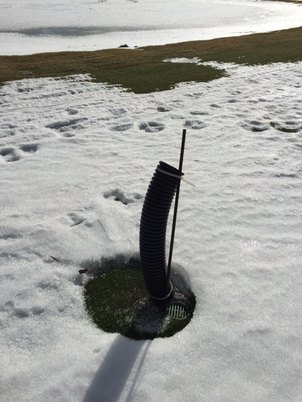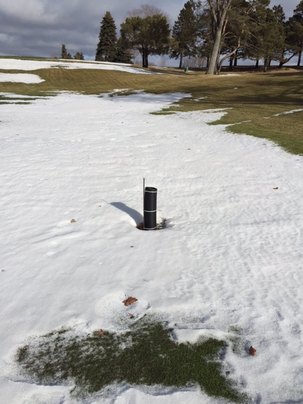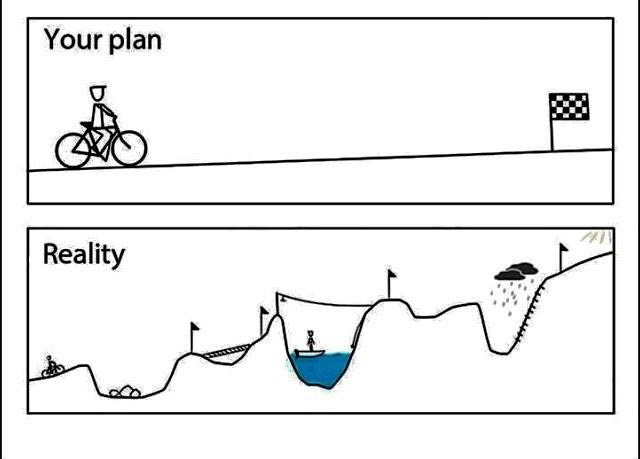We have reached what I would say is the middle of the Winter season. Has it been a positive or negative winter for the turf is the magical question? I’ll try to review what’s happened up to this point and explain what events have raised red flags and where I see optimism.
First click on the graph below and take a minute to look at the data of temperatures from the period of Thanksgiving to right now. Temperatures and snow are the two main aspects I look at for expected conditions and events.
It’s somewhat difficult to see the exact high and low temperatures over a long period of time in this graph but the overall curve is what’s important to observe. Ideally this graph line would be much flatter without the ups and downs. If you remember we had a white Thanksgiving with ~6″ of snow on the ground, then it became unusually warm right before the holidays with 3 days near the 50s just days before Christmas. This scenario of snowfalls followed by large melts has happened another 2 times since then. There are 4 main aspects that raise a red flag when this phenomenon takes place:
- First, the snow melt creates free flowing water which then creates ice at night when temperatures dip below the freezing point. Ice is never good for turf, especially Poa Annua. Again, we have a mixture of Poa Annua and Bentgrass on our Greens, Tees and Fairways. Poa has a typical survival range of 45-90 days under ice. Bentgrass can survive for up to 120 days under the same conditions. Believe it or not, grass still needs gas/oxygen exchange during the winter and under ice cover, gases build up and the turf basically suffocates. You will hear me discuss several reasons why we strive towards growing more Bentgrass at Midland and this is the main reason. With our short golf seasons, surviving Winter is absolutely key and Poa Annua is our largest liability in Winter survival.
- Second, the free flowing water breaks the Poa Annua’s dormancy mechanism which can lead to the Poa taking up the water into it’s crown. Poa loses its cold temperature, hardy proteins and begins to take up water quickly as temperatures warm during snow melts. As snow melts and water collects in low lying or poorly draining areas, if the temperature drops below freezing and ice forms, it can crush the swollen crowns of Poa annua plants, killing them. The damage resulting from freeze or thaw cycles is typically referred to as crown hydration injury. Again, Bentgrass has a better dormancy mechanism and stays dormant until soil temperatures rise in the Spring which gives it much better durability and survivability.
- Third, losing snow cover during winter months exposes the fine turf to subzero temperatures. If you look at the graph, right after the New Year, our nighttime low temperatures reached -20F. Without the insulation of snow, fine turf can become damaged from desiccation and direct low temperature kills, especially on areas that receive prevailing Northwest winds. After potentially breaking dormancy during warmer weather during the warm up, turf can have difficulty properly getting back into full dormancy in a short period of time. This is why Bentgrass is the preferred turf type because it more than likely didn’t break dormancy to begin with.
- Fourth, disease pressure from damaging snow molds increase with snow melts, sun exposure and plants utilizing the products applied to protect them. This aspect doesn’t discriminate turf types. Snow mold protectants are applied at the end of October with the intent to protect the turf for up to 5 months. Using the correct combination of chemistries and University-backed research proven products are key to prevent breakthroughs, however these products are designed to be under constant snow cover with no snow melt events or exposure to degrading sunlight.
So now that I’ve listed the potential negatives of this Winter’s weather events, what does it mean and are there positives? I’m definitely not trying to paint a negative picture but when looking at why turf is injured during the winter months, there are numerous aspects and variables to analyze and attempt to decipher what is actually happening to the turf. Each Winter presents unique weather and with climate change we manage and prepare the turf with our Agronomic practices that best fit patterns. Up to this point this is what I feel are our positives:
- First, we have the biggest positive working for us: We have no sustained ice. Luckily each time we’ve had a snow melt event, it’s been so warm that most of if not all of the snow melted and went into our drainage inlets and/or into the ground. Even in the Winter months, drainage is absolutely critical. Surface drainage, internal pipe drainage as well as aerification drainage work in our advantage to get the free flowing snow melt water off the playing surfaces and into the ground before it can form ice during the night. The pictures below show drain inlets on #3 and #8 Fairways. One of the things we’ve added to our management practices is small pieces of drain pipe suspended above ground that create a wind vortex and absorb heat to keep the ground inlets open from snow and ice. This allows the snow melt water to get into the ground as quick as possible. We also have removed trees around Greens, Tees and close proximity to Fairways to prevent shade from slowing the melting process and preserving ice accumulations.
We also spray dyes and pigments leading up to snowfall to get the turf as dark green as possible. The reason being is if the snow is going to melt, we want it to absorb as much solar radiation as possible and melt it as quick as possible and hopefully get the water into the ground and/or drain inlets. We spray these products to create an artificial environment to also heat up the ground as quickly as possible come Spring so the turf starts to grow. This works to our advantage in the Spring but is debatable if it’s a positive when we have multiple snow melts during Winter because it potentially could assist the Poa Annua in breaking dormancy early. Again, we manage towards long term Winter averages and this Winter is not following the normal curve. The pictures below of #8 Fairway and #1 Tee show a good contrast of how dark green the pigments and dyes make the fine turf compared to the rough. Now you can see the potential it has to assist with melting snow with it’s deep and dark color.
- With all of the snow melt getting into the ground it has prevented much desiccation of turf while exposed to very cold temperatures. This is unusual in that it warms up enough to get the snow melt into the ground on several occasions but there is very little to no frost in the ground. When the temperatures dip below zero the air becomes extremely dry and pulls moisture out of the plants and can even decimate any ice that has formed on the turf. We’ve basically avoided the potential to dry out because of the several snow melt events. We’ve also received timely snowfalls right before the temperatures have dipped into that dangerous zone that has given us proper insulation. I’m hoping that trend continues going forward.
- We practice good agronomics and far as the Greens are concerned, we use what we feel is the correct type of cover to fit each specific green. Our Greens are most vulnerable to Winter damage because of their height of cut, exposure and high maintenance levels. Our greens are 95 years old, they each have their own soil and drainage characteristics so we have to manage them accordingly. The Greens Committee stands behind the proper Agronomic practices to maintain a healthy stand of turf that gives us the best chances of surviving adverse weather conditions. Aerification being the most prevalent practice that promotes deep rooting, increased drainage, decreased compaction and improving our subsoil make-up.
As a whole, we have seen a roller coaster of weather but I’m very optimistic as of today. We have no sustained ice,we’ve had good insulation from small timely snowfalls when it’s become dangerously cold, the ground has plenty of moisture and we have more Bentgrass than in years past which gives us a getter chance of survival from the roller coaster weather.
I used to think that the above picture was the right mantra for managing a golf course. Over time and gained experience has shown that we need to plan for the ups and down and the unexpected. There is nothing that dictates the playability and survivability more than the weather and it’s unfortunately the one thing we cannot control. We make our agronomic decisions that will proactively give us the best outcome regardless of outside variables.
Here’s to a quiet and positive remainder of the Winter season!
Mike Manthey
GCS








Nice report … easy to follow and understand. Thanks!!